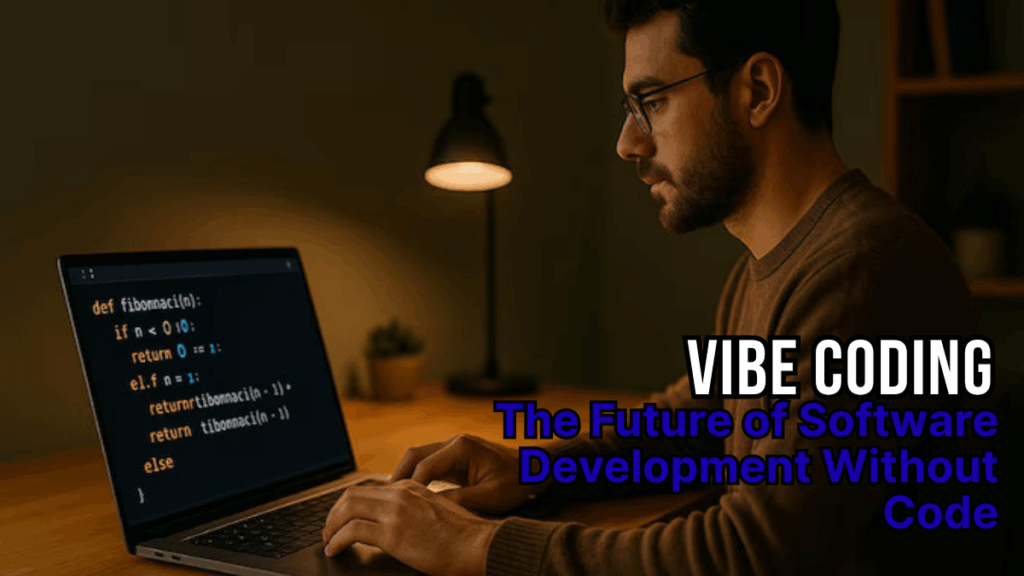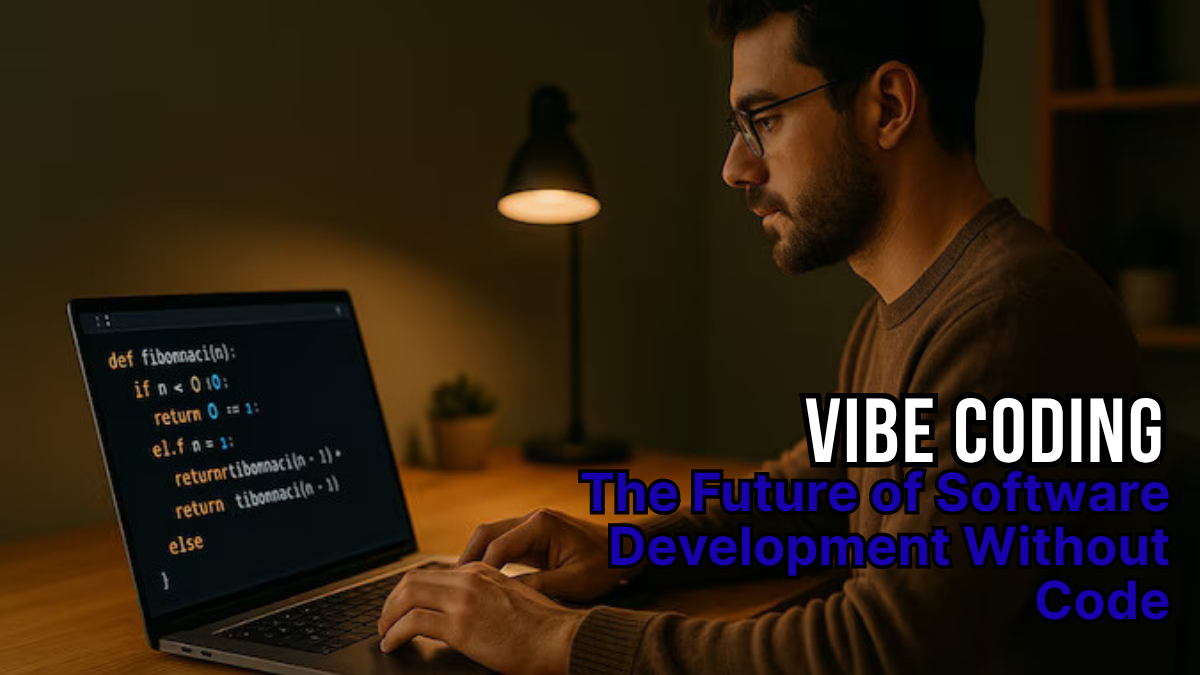Software development is experiencing a revolutionary shift. For decades, building applications required mastering complex programming languages, spending countless hours debugging code, and navigating intricate technical frameworks. Today, a new approach called “vibe coding” is transforming how we think about software creation allowing anyone to build functional applications using nothing more than plain English descriptions.

This emerging trend represents more than just a technological advancement. It’s democratizing software development, making it accessible to entrepreneurs, business leaders, and creative professionals who previously needed extensive technical expertise or large development teams to bring their ideas to life.
What Is Vibe Coding?
Vibe coding is a revolutionary approach to software development where artificial intelligence translates natural language instructions into functional code. Rather than writing lines of code manually, developers and non-developers alike can simply describe what they want to build, and AI handles the technical implementation.
The term was popularized by Andrej Karpathy, former Director of AI at Tesla and OpenAI researcher, who described it as letting go of traditional coding constraints and focusing purely on intent. Instead of worrying about syntax, debugging, or technical implementation details, you communicate your vision in everyday language.
This approach fundamentally changes the relationship between humans and computers. You become the architect of ideas while AI serves as your skilled technical assistant, handling the complex coding work that previously required years of training to master.
How Vibe Coding Differs from Traditional Development
Traditional software development follows a rigid process. Developers must learn programming languages like Python, Java, or JavaScript, understand complex frameworks, and manually write every function, feature, and interaction. A simple calculator app might require hundreds of lines of code, extensive testing, and weeks of development time.
Vibe coding flips this model entirely. Instead of writing code, you provide high-level descriptions of what you want to achieve. The AI interprets your instructions, generates the necessary code, and creates functional software. What once took weeks can now be accomplished in hours or even minutes.
Here’s how the two approaches compare in practice:
Traditional coding process:
- Learn programming languages and frameworks
- Write detailed code for every function
- Debug errors and optimize performance
- Test extensively before deployment
- Maintain and update code manually
Vibe coding process:
- Describe your app idea in plain language
- AI generates functional code automatically
- Test and refine through additional instructions
- Deploy quickly with minimal technical knowledge
- Update features through simple conversations with AI
The speed difference is remarkable. Where traditional development might take a team of developers months to build a prototype, vibe coding can produce working applications in days.
The Business Revolution Behind Vibe Coding
Companies across industries are embracing vibe coding to accelerate innovation and reduce development costs. This shift is particularly powerful for startups and small businesses that previously couldn’t afford extensive development teams.
Faster Time to Market
Businesses can now validate ideas and build prototypes rapidly. Instead of spending months developing a minimum viable product (MVP), entrepreneurs can create functional applications quickly, test them with real users, and iterate based on feedback. This speed advantage is crucial in competitive markets where being first can determine success.
Cost Reduction
Traditional software development requires hiring skilled developers, often at premium salaries. Vibe coding reduces dependency on large technical teams, allowing businesses to allocate resources more efficiently. A product manager or entrepreneur can now build functional prototypes without needing a full development team.
Increased Innovation
When building software becomes as simple as describing an idea, the barrier to experimentation disappears. Teams can test multiple concepts, explore creative solutions, and pivot quickly without significant technical overhead. This freedom to experiment leads to more innovative products and services.
Democratized Development
Vibe coding empowers non-technical team members to contribute directly to product development. Marketing professionals can build their own analytics tools, sales teams can create custom CRM features, and customer service representatives can develop automated support systems.
Real-World Applications Transforming Industries
Startup Prototyping
Entrepreneurs are using vibe coding to build functional prototypes in record time. Instead of spending months seeking technical co-founders or raising funds for development teams, they can validate their ideas quickly and demonstrate working products to potential investors.
Internal Business Tools
Companies are creating custom internal applications without involving IT departments. Sales teams build lead tracking systems, HR departments create employee onboarding tools, and marketing teams develop campaign management platforms for all through simple conversations with AI.
E-commerce Solutions
Online retailers are customizing their platforms rapidly. They can add new features like recommendation engines, inventory management systems, or customer support chatbots by describing their requirements rather than hiring developers.
Educational Technology
Educators are building interactive learning tools, quiz platforms, and student management systems. Teachers with no programming background can create educational games, progress tracking systems, and personalized learning experiences.
Healthcare Innovation
Medical professionals are developing patient management tools, appointment scheduling systems, and health monitoring applications. This allows healthcare providers to create solutions tailored to their specific needs without waiting for large-scale software development projects.
Tools and Platforms Leading the Revolution
Several platforms are making vibe coding accessible to everyone:
Replit offers an AI-powered development environment where 75% of users create software without writing any code. The platform provides a conversational interface that transforms ideas into functional applications.
Cursor serves as an AI-first code editor that understands natural language instructions and generates complete applications based on user descriptions.
ChatGPT and Claude can generate functional code from detailed descriptions, making them powerful tools for rapid prototyping and development.
Menlo Park Lab demonstrates vibe coding’s potential by creating products like Brainy Docs, which transforms PDFs into explainer videos using AI-generated code from simple prompts.
These platforms are continuously improving, making vibe coding more powerful and accessible to users with varying technical backgrounds.
Overcoming Challenges and Limitations
While vibe coding offers tremendous advantages, it’s important to understand its current limitations and how to address them effectively.
Quality Control
AI-generated code may not always be optimized for performance or security. Successful vibe coding requires iterative refinement and, for complex applications, review by experienced developers. The key is treating AI as a powerful starting point rather than a complete solution.
Complex Applications
While vibe coding excels at creating prototypes and simple applications, highly complex systems still benefit from traditional development approaches. The most effective strategy often combines both methods of using vibe coding for rapid prototyping and traditional development for production-ready systems.
Security Considerations
AI-generated code can introduce security vulnerabilities if not properly reviewed. Businesses must implement testing procedures and security audits, especially for applications handling sensitive data or financial transactions.
Dependency on AI Capabilities
Vibe coding effectiveness depends on the AI model’s training data and capabilities. As these systems continue improving, their ability to handle complex requirements and generate sophisticated applications will expand significantly.
Getting Started with Vibe Coding
Choose the Right Platform
Start with user-friendly platforms like Replit or Cursor that are designed for vibe coding. These environments provide AI assistance and handle technical setup automatically.
Start Small
Begin with simple projects like basic websites, calculators, or simple games. This allows you to understand how AI interprets your instructions and how to communicate effectively with the system.
Be Specific in Your Instructions
Instead of vague requests like “build a website,” provide detailed descriptions: “Create a portfolio website with a header, navigation menu, about section, project gallery, and contact form. Use a modern, clean design with blue and white colors.”
Iterate and Refine
Vibe coding is an iterative process. Start with a basic version, test it, then provide additional instructions to improve functionality, design, or performance.
Learn from the Output
Even though you’re not writing code manually, understanding what the AI generates helps you provide better instructions and catch potential issues early.
The Strategic Advantage for Forward-Thinking Businesses
Companies that embrace vibe coding now will gain significant competitive advantages as the technology matures. Early adopters can build internal capabilities, train their teams, and establish processes that will become increasingly valuable as AI-assisted development becomes mainstream.
The shift toward vibe coding represents a fundamental change in how businesses approach technology. Instead of viewing software development as a specialized technical function, it becomes a creative process accessible to anyone with ideas and vision.
Organizations that adapt quickly can respond to market changes faster, experiment with new solutions more freely, and innovate without traditional technical constraints. This agility will become increasingly important as business environments become more dynamic and competitive.
Preparing for an AI-Driven Development Future
The rise of vibe coding signals a broader transformation in how we interact with technology. As AI systems become more sophisticated, the barrier between human ideas and digital implementation will continue to shrink.
This evolution doesn’t eliminate the need for skilled developers, instead of it elevates their role. Developers will focus on complex problem-solving, system architecture, and AI oversight rather than routine coding tasks. Meanwhile, creative professionals, entrepreneurs, and business leaders will gain direct access to software creation capabilities.
The future belongs to those who can effectively communicate their vision to AI systems and iterate rapidly based on results. Whether you’re a startup founder, business leader, or creative professional, developing vibe coding skills will become as valuable as traditional business competencies.
Vibe coding represents more than a new development methodology. It’s a glimpse into a future where human creativity and artificial intelligence combine to turn ideas into reality faster than ever before. The question isn’t whether this technology will reshape software development, but how quickly you’ll adapt to leverage its transformative potential.
FAQs
Q. What is vibe coding?
A. Vibe coding is a revolutionary approach to software development where you can create applications by simply describing your ideas in plain language. Leveraging AI technology, the code is automatically generated for you, eliminating the need for traditional programming skills.
Q. Do I need to know how to code to use vibe coding?
A. No coding experience is required! Vibe coding is designed to be accessible to everyone. Just articulate your concept clearly, and the AI does the rest.
Q. What kind of applications can I create with vibe coding?
A. You can create a wide variety of applications, from mobile apps to web platforms and even complex data-processing tools. The versatility of vibe coding allows you to bring your unique ideas to life, regardless of complexity.
Q. How secure are the applications built using vibe coding?
A. Applications built using vibe coding follow industry security standards. The AI tools incorporate best practices to ensure your app is stable and secure, but additional security reviews are always recommended for sensitive projects.
Q. Can AI understand complex ideas for app development?
A. Absolutely. Advanced AI algorithms are capable of understanding detailed and complex ideas. The better you describe your requirements, the more tailored your application will be to meet your needs.
For More Information Click HERE

